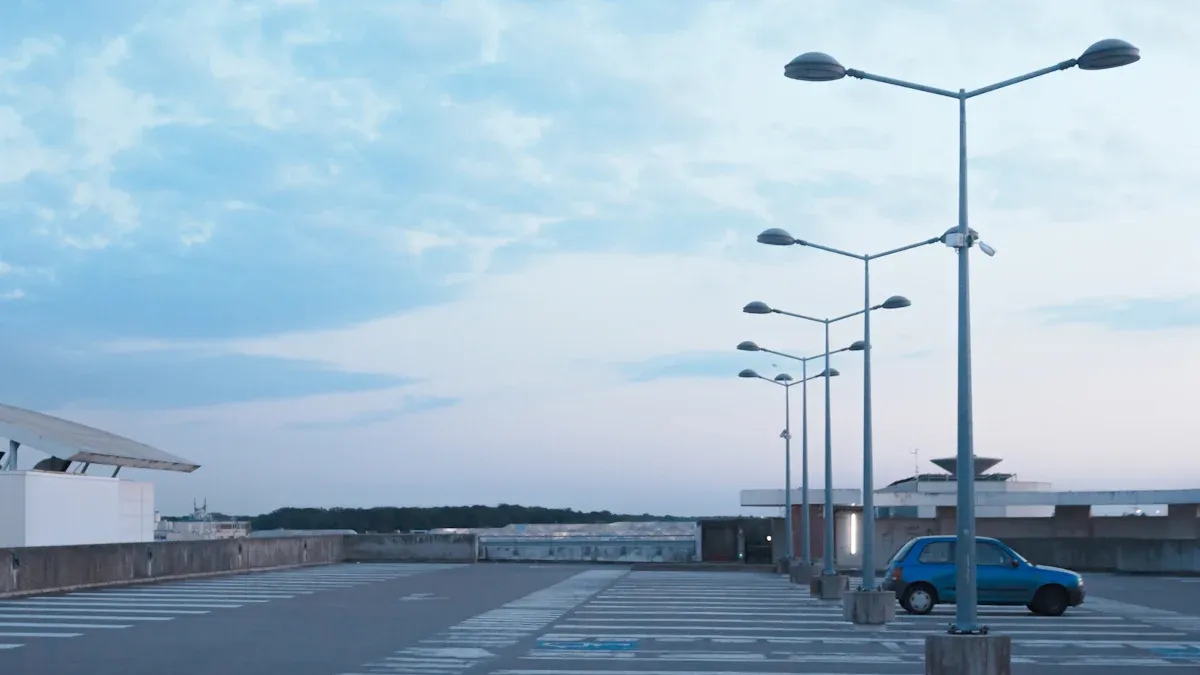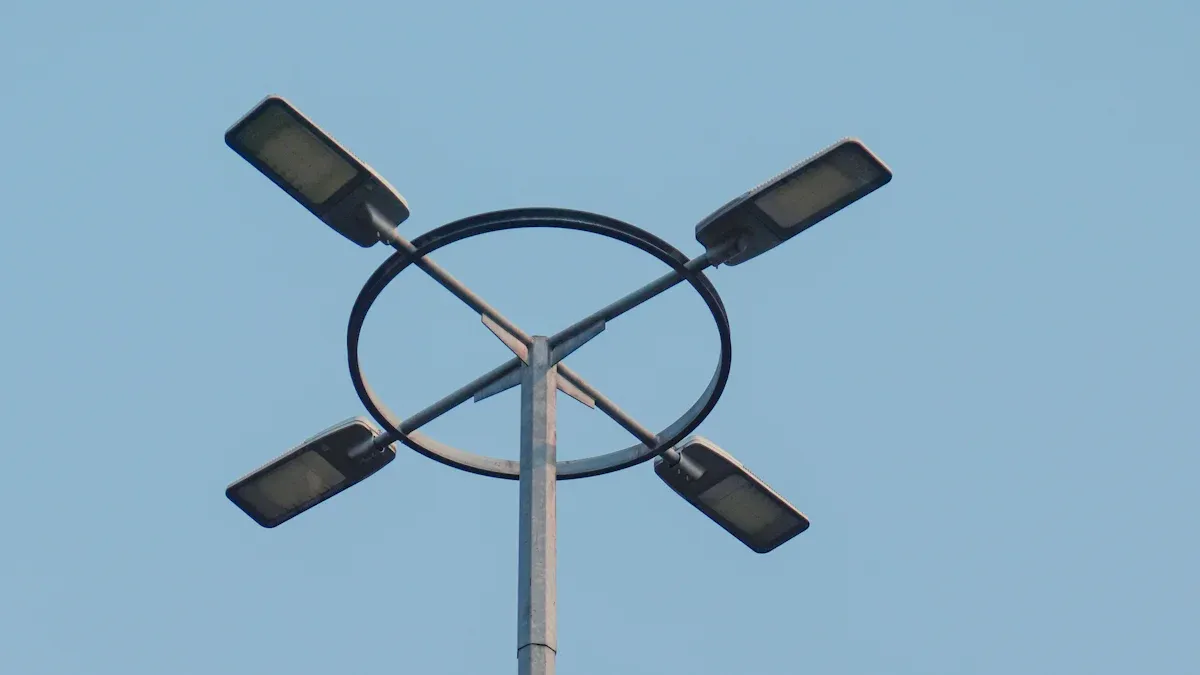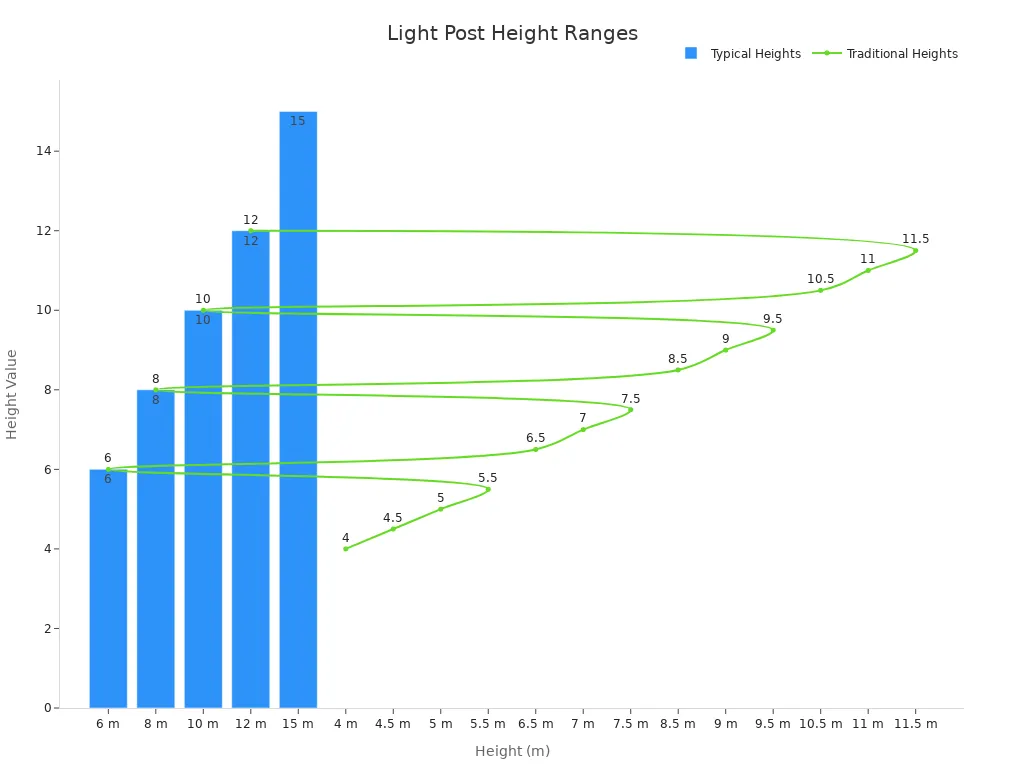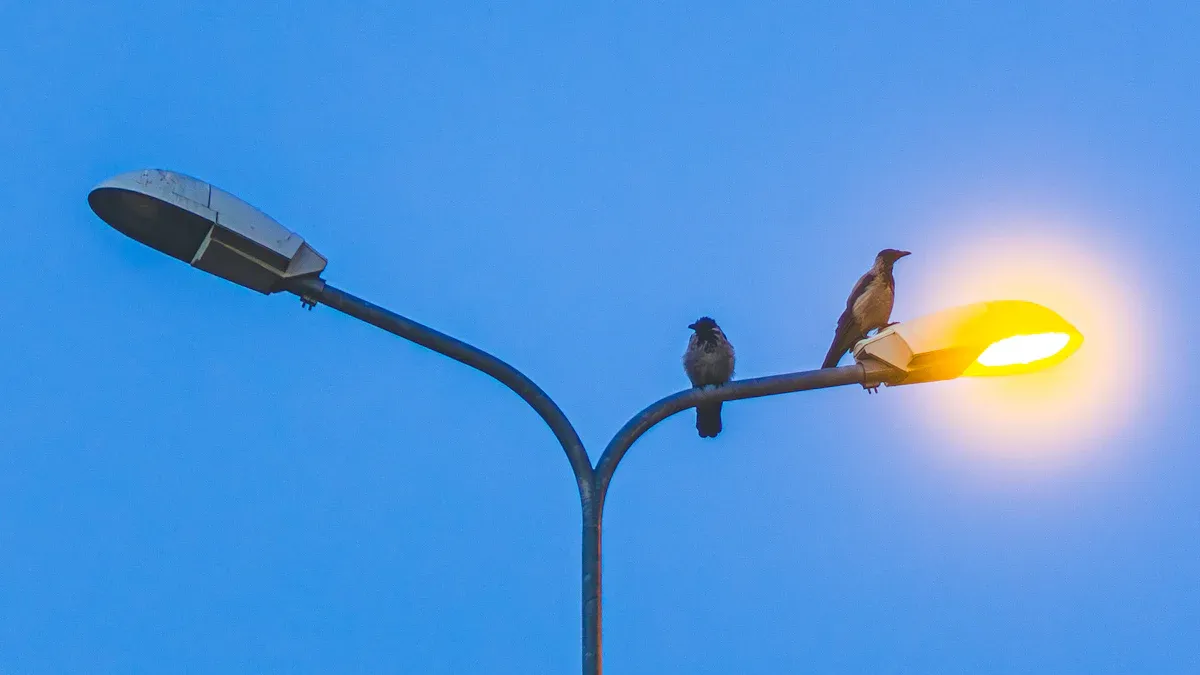Light Post Heights and Standard Measurements for Different Applications

Standard light post heights vary by application. Streets often use light poles between 15 and 50 feet. Parking lots and commercial areas commonly require 15 to 35 feet. Residential and park lampposts usually stand 10 to 25 feet. Sports fields may need even taller poles. The importance of light pole height lies in safety, visibility, and compliance. Factors such as road width, area size, and local rules affect each light pole application. For more details, visit the Home, About Us, Product, or Led Light sections.
Proper light post heights help streets stay safe and well-lit.
Key Takeaways
Picking the right light post height helps people see better and stay safe in streets, parks, and parking lots. - Different places need different pole heights. These usually range from 10 to 65 feet. The height depends on where and how the pole is used. - Things like road width, area size, lighting technology, and local rules help decide the best pole height for each place. - Good planning and following safety rules stop glare, save energy, and protect people and property. - Checking light poles often and installing them well keeps them strong, useful, and lasting a long time.
Standard Light Post Heights

Picking the right light pole height keeps people safe. It also helps everyone see better and follow the rules. Different places need different pole heights. This depends on how the area is used and what is around it. The table below shows common light pole heights and what to think about for each use:
Application Area | Typical Height Range (feet) | Key Specifications and Considerations |
|---|---|---|
Residential Streets | 10–15 | Warm light, low glare, close spacing |
Commercial/Parking Lots | 20–30 | Wide coverage, security, uniform lighting |
Parks/Decorative Areas | 10–16 | Lower poles for ambiance, wildlife protection |
Major Streets/Highways | 25–50+ | High visibility, wide road coverage, reduced glare |
Sports Fields | 40–65+ | Maximum area coverage, high intensity, safety |
Note: The best height for each place depends on how wide the road is, how big the area is, and local rules.

Street Light Poles
Street light poles help keep roads bright and safe. The height of these poles is usually the same as the street’s width or a little taller. Most city streets use poles that are 15 to 30 feet tall. In neighborhoods, poles are often 10 to 15 feet high. Big roads and highways use much taller poles, from 25 to over 50 feet. The height changes how far the light shines and how much of the road it covers. Good spacing and the right pole height stop dark spots and too much glare. Rules from around the world and local laws help decide the best height for street light poles.
Parking Lot Light Poles
Parking lots need bright lights for safety and to stop crime. Light poles in parking lots are usually 15 to 35 feet tall. Small parking lots use shorter poles, about 12 to 20 feet. Big parking lots need taller poles, up to 35 feet, to light up the whole space. The size of the lot, how many lights there are, and how much light is needed all matter. Tall poles can light bigger areas with fewer lights, which saves energy. In cities, shorter poles are used so homes nearby are not too bright. In the country, taller poles are okay for more light.
Residential and Park Areas
Homes and parks use shorter light poles to make things cozy and safe. In neighborhoods, poles are usually 10 to 15 feet tall. Parks and fancy areas use poles from 10 to 16 feet. Shorter poles help stop glare and protect animals like birds. In busy places, poles can be up to 25 feet tall for more light. These places care about safety, good light, and not making too much light pollution. The right pole height and spacing make these areas nice and safe for everyone.
Commercial and Industrial Uses
Stores and factories need strong, even lighting. These places use poles that are 20 to 30 feet tall. Some factories and sports fields use poles up to 65 feet. Tall poles mean you need fewer lights to cover a big area, which saves energy. The kind of light, how it shines, and following the rules all matter. The right height and spacing keep the area bright, safe, and not too expensive. New LED lights and smart systems also help pick the best pole height by giving better control and saving energy.
Influencing Factors
Area Size and Road Width
The size of an area and the width of a road matter a lot. Wide roads need taller poles to light all the lanes. Short roads use shorter poles for better control and less glare. Big parking lots need higher poles to cover more space with fewer lights. Small parks or homes use shorter poles to feel cozy. The space between poles is called spacing. Good spacing stops dark spots and keeps light even. These things help planners pick the right pole height for each place.
Lighting Technology
Lighting technology changes how well places get lit. Led street lamps have changed how cities light up streets and parks. These lamps are bright, clear, and use less energy. Led street lamps can shine farther and more evenly than old lights. This lets cities use fewer poles or put them farther apart. Led street lamps also let planners change brightness at different times. Many cities now use led street lamps to save money and make places safer. The type of lamp affects how many poles are needed and how tall they should be.
Regulations and Safety
Rules and safety laws guide every lighting job. City ordinances set how tall light poles can be in each area. City ordinances also control how much light shines into homes or on roads. Local rules make builders follow a code for safe lighting. The code says how tall, bright, and where poles go. City ordinances often match national safety codes. The Federal Highway Administration says the right pole height keeps drivers and walkers safe. The FAA has rules for tall poles near airports. Poles over 200 feet must follow strict rules to keep planes safe. These rules make sure lights do not cause accidents. Following the code keeps everyone safe and helps cities avoid trouble.
Choosing the Right Light Pole Height
Project Assessment
Picking the right light pole height starts with a careful plan. Planners use steps to make sure the lights fit the area and work well:
Figure out where the pole will go. Streets, parks, and stores need different heights. Small streets often use 15–20 feet. Wide roads may need 25–50 feet.
Think about the place. City, country, and business areas change how tall poles should be and where they go.
Check the local rules. Cities and states have rules for how tall poles can be and how much glare is allowed.
Look at what is needed for the job. Tall poles need strong materials and deep bases. Steel is very strong. Aluminum is lighter but not as strong. Wind can push on poles, so planners check wind charts and pick the best shape.
See how big the area is and how bright the lights are. Big places and strong lights often need taller poles to spread light evenly.
Planners use all this information to pick a good height. This helps keep the area safe and bright.
Tip: Good planning stops dark spots and saves energy.
Compliance and Safety
Following the rules keeps people and property safe. Planners look at city and national codes before putting up poles. These rules stop glare and keep lights from shining into homes. They also help keep everyone safe. The Federal Highway Administration and FAA have extra rules for highways and near airports. Following these rules helps stop accidents and keeps people safe. Checking and fixing poles often keeps them the right height and in good shape.
Environmental Considerations
The environment is important when picking pole height. Shorter poles in parks and neighborhoods help stop too much light and protect animals. Planners use shields and soft-colored lights to cut glare. They also pick LED lights to save energy. Good pole placement means not lighting places that do not need it. This saves energy and helps nature stay healthy.
Streetlights and Standard Height Guidelines

Measuring Light Pole Height
Measuring light pole height the right way is important. This makes sure streetlights are safe and bright enough. Workers measure from the ground up to the top of the light. They use a tape measure or a laser tool for tall poles. They check the height before and after putting up the pole. This helps make sure the pole is the right height. After the pole is up, checking again can show if it leans or sinks. Regular checks help keep lights even and safe for people and cars.
Installation Tips
Installing light poles the right way keeps them strong and at the right height. There are two main ways to put up poles. One way uses anchor base poles with bolts in concrete. The other way puts the pole straight into the ground with backfill. Knowing how tall the pole should be above the ground is important. Tall poles need to be wider and have deeper bases to stay up. Round tapered poles are better in strong winds and storms.
Installation Aspect | Description & Performance Data |
|---|---|
Anchor base poles use bolts in concrete. Direct burial poles go into the ground with backfill. Knowing the height above ground is needed to keep the pole at the right height. | |
Structural Integrity | Tall poles need to be wider and have deeper bases. Round tapered poles are more stable. |
Material Choice | Steel is the strongest. Fiberglass is next. Aluminum is not as strong and needs to be thicker. The material changes how much weight the pole can hold and how well it keeps its height. |
Wind Resistance | Wind load tables help pick the right pole for windy places. Round tapered poles stand up better in wind and stay at the right height. |
Installers check the ground and use special bases if the ground is not flat. Good ground work and strong bases stop the pole from leaning. Weather like wind and heat changes what materials and designs are best. Strong designs and good materials help poles last longer and keep the light at the right height. Checking poles often and watching the weather helps keep lights safe and working well.
Tip: If you follow these steps when putting up light poles, the lights will stay at the right height and work safely.
Picking the right light post height helps keep people safe. It also makes sure places are bright enough. Different places, like streets or parks, have their own standard. Planners need to look at how big the area is. They also check what kind of lights to use and what the local rules say before starting.
Look at local codes and safety rules.
Use good tools or lighting calculators to help.
Ask a lighting expert or call the city office for help.
Good planning and expert advice make sure the lights work well and follow all the rules.
FAQ
What is the most common height for street light poles?
Most street light poles stand between 15 and 30 feet tall. City planners choose this height to give good visibility and safety for drivers and pedestrians.
Why do sports fields use taller light poles?
Sports fields need tall poles, often 40 to 65 feet high. These poles help spread bright light over a large area. Players and fans can see clearly during games.
How do local rules affect light pole height?
Local codes set limits for pole height and brightness. Planners must follow these rules to keep neighborhoods safe and avoid too much glare.
Can LED lights change the needed pole height?
LED lights shine brighter and more evenly than older lights. Planners sometimes use fewer or shorter poles with LEDs. This saves energy and keeps lighting effective.
How often should workers check light pole height and condition?
Experts recommend checking light poles every year. Regular checks help find leaning poles, rust, or damage. This keeps lights safe and working well.
See Also
How To Choose Street Light Posts Based On Materials And Height
Selecting The Best LED Street Light Poles For Installation
Step By Step Guide To Installing Light Pole Posts
Durable And Safe Street Light Pole Installation Best Practices
Everything You Need To Know About High Bay Light Installation

